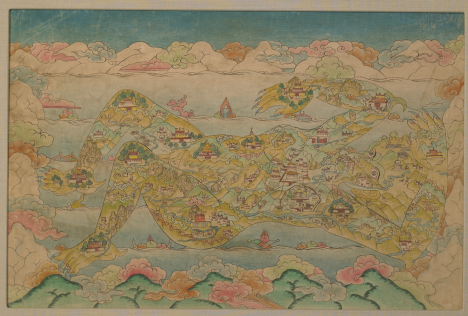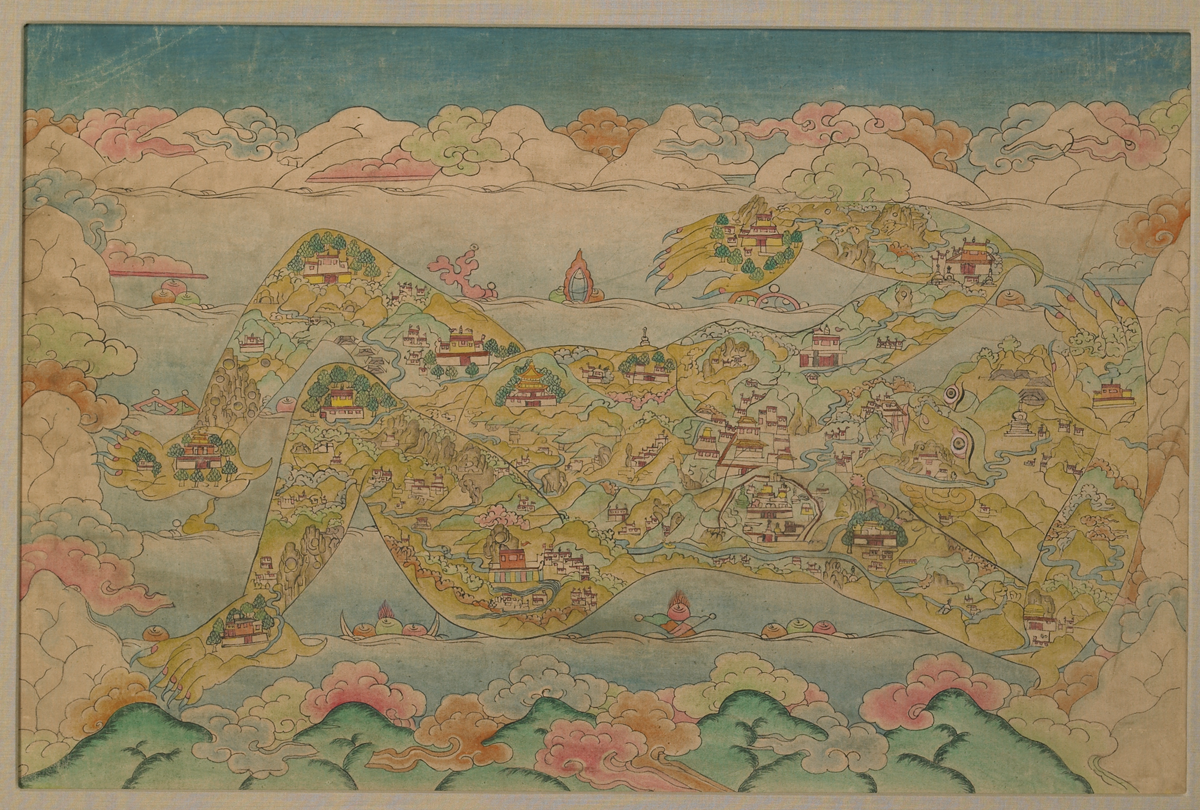
Take a look at the painting below, now on view in the exhibition Monumental Lhasa: Fortress, Palace, Temple. It depicts the demoness said to be lying across the whole of Tibet. If you look closely you’ll see that prominent structures pin her to the ground and both natural and man-made landscapes form her anatomy.
What is this painting about? How did the demoness get to be pinned to the earth? What are the buildings on her body?
Tibetan scholar Martin A. Mills recounts the rich story behind the painting, including the discovery of the demoness and how Chinese and Himalayan traditions converged in the founding of one of Tibet’s best-known structures.

Tibetan Geomancy: Converging Cultures
The “supine demoness,” a late-nineteenth-century symbolic depiction of the land of Tibet, draws on the great post-dynastic histories of the Jokhang Temple at Lhasa. The image is iconic of Tibet’s rich tradition of geomancy—the art and ritual of landscape. An indispensable facet of religious life across the Plateau, Tibetan geomancy (or jungtsi, “counting the elements”) united the long-established indigenous worship of mountain gods with Chinese concepts of feng shui and Indian tantra to create a rich religious science of moral well-being, community prosperity, and auspicious rule.
The Troubled Beginnings of the Jokhang
The image of the supine demoness comes from the history of the Jokhang Temple—regularly recounted from the eleventh century onwards in texts such as the Pillar Testament and the Compendium of Manis.Emperor Songtsen Gampo sought to found a tutelary temple to his patron Buddhist deity Chenresik to mark his marriage to his Nepalese bride Tritsun. The project did not go unhindered, however: every day his workers built the foundation walls of the temple, but found them destroyed the next morning.
Inauspicious Influences
In consternation, the emperor turned to his Chinese wife, Wengchen Kongjo, recently arrived from the courts of Tang dynasty China. Skilled in feng shui, Kongjo consulted the Portang divination charts, and declared that the Lhasa Valley was filled with inauspicious signs that hindered the building of such a kingly temple: that the land of Tibet itself was like a she-demon (sinmo) lying on her back; that the Ö-Thang Lake upon which the temple was built was her heart blood; that the three great hills of Lhasa were her breasts and sternum; that Central Tibet itself was her body; and that her limbs stretched far into the hinterlands of the Plateau, from Amdo in the North and the Himalayas in the South to Kashmir in the West.
In its present state, Kongjo declared, the land of Tibet remained wild and untamed, an absolute obstacle to the building of the royal temple and the future of the king’s religion. Nonetheless, the Valley of Lhasa also contained auspicious features, shaped as parts of the body of the Buddha: a mountain shaped like twin fish, a sign representing the Buddha’s eyes; another like a vase, for his neck; a victory banner for his body, and an endless knot symbolizing his mind. These auspicious signs, the princess declared, were suppressed aspects of the land, waiting to be revealed.

To reverse the negative influences, reveal the auspicious ones, and thereby allow the completion of the Jokhang, the emperor followed Kongjo’s advice to first build twelve temples to “nail down” the limbs and body of the demoness. These can be seen on the painting, marking the “fire veins” (mé-tsa) of her body: four central district temples to nail down her shoulders and hips, four border temples for her elbows and knees; and four “further taming” temples to subdue her feet and hands amongst the surrounding border tribes. In addition to these, the painting depicts the central temple at Lhasa, and to the south, the walled enclosure of Samyé, Tibet’s first royal monastery.
Explore the “nailing down” of temples in this online painting interactive
Debates about the Demoness: The Suppressed Feminine?
The image of the supine demoness has been the subject of considerable scholarly debate, the most common of which is to see it as a female divine stereotype, symbolically suppressed by a male-dominated Buddhist monastic elite. As tempting as it may be, this is a somewhat anachronistic reading, not least because the image itself emerges from a princess rather than a monk, within a tale of royal marriage largely devoid of any references to monasticism.
More likely, the image is drawn from the standard repertoire of Tang dynasty royal feng shui, with which the full story shares many features, including the ability to combine surrounding landscape forms into a united “˜body’. The extent of the demoness’ limbs corresponds broadly with the limits of the emperor’s rule and military conquests, which became in subsequent centuries associated with the boundaries of Greater Tibet (böd chenmo), the province of Tibet’s celestial protector, the bodhisattva Avalokiteshvara (Chenresik).
The precise historical provenance of Songtsen Gampo’s “nailing down” temples remains unclear, although it is certain that all have existed at some point, and some of the remaining examples show clear signs of the kind of Newar architecture and styles contemporaneous to the Lhasa Jokhang itself. Many were renovated by subsequent kings and rulers as a sign of their mastery over Songtsen Gampo’s city, not least the Fifth Dalai Lama in the seventeenth century. To this day, the auspicious signs of the Buddha divined by Kongjo in the Valley landscape remain popular pilgrimage and picnic spots for Tibetans.
Discover dozens of other stories told through depictions of Tibet in Monumental Lhasa: Fortress, Palace, Temple.
About the Author
Dr. Martin A. Mills is Senior Lecturer in Anthropology at the University of Aberdeen, Scotland and co-founder of the Scottish Centre for Himalayan Research. Author of Identity, Ritual and State in Tibetan Buddhism: The Foundations of Authority in Gelukpa Monasticism (Routledge, 2003), his principal research is the anthropological study of Tibetan communities, in particular its religious and governmental institutions. Over the last twenty years, he has carried out fieldwork in Tibet, Ladakh, China, Northern India, and Scotland.

